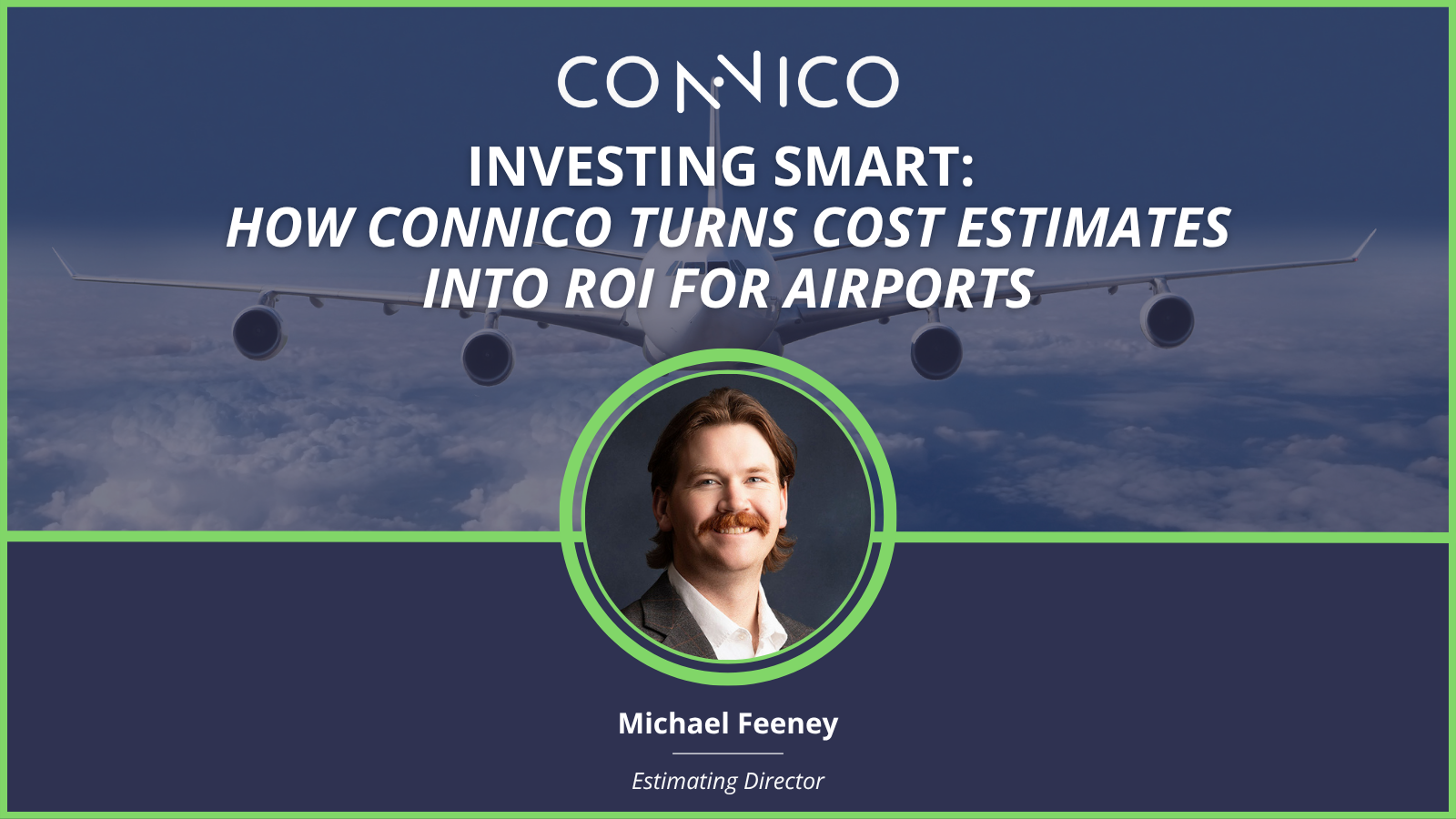Investing smart: How Connico turns cost estimates into ROI for airports

Airport projects represent some of the largest public infrastructure investments, meaning they come with big expectations. Leaders want assurance that every dollar spent will deliver measurable value for the community, airlines, and passengers alike.
With more than 35 years of experience in cost estimating and program management, Connico helps decision-makers transform complex data into clear insights: balancing budgets, mitigating risk, and investing resources where they matter most. As AI and automation enter the cost estimating conversation, Connico’s balance of human expertise and technology ensures airports not only meet but exceed their return on investment (ROI) goals.
Estimating Director Michael Feeney has spent the last seven years leading complex airport programs at Connico, and contributes a deep understanding of how cost, design, and operations intersect to create long-term value. Read on to explore Michael’s expert insights on how thoughtful cost estimating can drive meaningful returns for airport projects.
Hidden factors that shape cost estimating
Assumption: Cost estimating is just about crunching numbers.
Reality: It’s about analyzing scope, materials, risks, and life-cycle costs to ensure investments make sense long term.
Airports face constant uncertainty – from fluctuating material costs to shifting regulatory requirements. Connico’s role is to bridge the gap between what’s known and what’s possible, helping clients plan for a range of outcomes before construction even begins.
For example, at Raleigh-Durham International Airport (RDU), Connico prepared comparative estimates for both a five-story and a nine-story parking garage. These side-by-side projections gave RDU’s financial planners the data they needed to identify which design would deliver the strongest ROI.
Connico’s approach goes far beyond tallying figures. Every estimate is a strategic tool designed to help airports understand the true scale and value of their investments. This process also includes evaluating market conditions, anticipating material price fluctuations like steel tariffs, and even factoring in upcoming large-scale events (like the Olympics in Los Angeles) that could affect timelines or availability.
Take the Indianapolis International Airport project, where Connico developed a cost model to help determine the break-even point for a new pavement configuration compared to aircraft taxi times. That evaluation helped balance operational efficiency with capital costs, ensuring the final design produced both performance improvements and long-term ROI.
Whether it’s a new terminal, expanded concession space, or a multi-level parking structure, Connico helps clients explore when and how each investment will pay off.
Keeping projects cleared for takeoff (and on budget)
The key to keeping airport projects on track and on budget lies in defining realistic costs early, and managing them consistently throughout design and construction.
Connico helps clients:
- Define construction costs by accounting for materials, labor, commodity volatility, and local factors such as weather or regional events.
- Identify assumptions early, setting realistic expectations that can make or break a project.
- Provide conservative estimates that empower owners to approach projects with confidence.
During the Runway 5R-23L Reconstruction at Indianapolis International Airport, Connico evaluated how redesigning the airfield’s geometry would improve taxiing efficiency and reduce maintenance costs. Those insights helped justify the investment and ensured that the reconstructed airfield would deliver lasting operational and financial benefits.
By monitoring for construction and maintenance costs, creating conservative high-end estimates, and developing scenario-based plans, Connico helps airports make well-informed financial decisions.
Efficiency meets insight: How AI and human expertise can coexist
AI tools have become increasingly capable of analyzing historical data and generating rapid cost models. While this technology offers efficiency and speed, it’s not a replacement for human insight, especially in the nuanced world of airport infrastructure.
AI can help estimate maintenance trends or forecast long-term costs, but it often misses the “gray areas” that determine real-world feasibility. Site logistics, disposal costs, or constructability challenges are AI blind spots. For instance, some emerging AI tools claim that quantity takeoffs are obsolete. In reality, quantity takeoffs, essentially a project’s detailed shopping list, are critical to creating accurate budgets and timelines. These are precisely the details human estimators are trained to catch.
Connico leverages both worlds: using data-driven tools for speed and precision, while relying on human creativity and experience to interpret results, challenge assumptions, and uncover value that automation alone can’t deliver.
Building ROI that lasts
Cost estimating isn’t about predicting numbers. It’s about ensuring investments pay off.
In the real world, projects are three-dimensional, even if plans exist only on paper. Human expertise brings those plans to life by evaluating not just what will be built, but how it will be built – and how that process will influence costs, timelines, and long-term value.
Connico equips airport leaders with the clarity, foresight, and confidence to make decisions that lead to meaningful ROI for their facilities, their passengers, and their communities.
Ready to see how a smarter cost-benefit analysis can drive your next project’s success?
Contact Connico to start the conversation.



